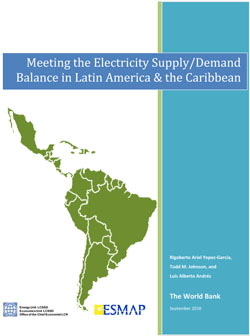News
 A new World Bank study says Latin American and Caribbean countries could boost region-wide electricity supply by 30 percent by 2030 by diversifying the energy mix to include hydropower, natural gas, and renewable energy. Improved power sector planning, increased regional electricity trade, and reduced energy waste among utility firms, industries and households by adopting energy efficient measures would also have a dramatic impact, the study says.
A new World Bank study says Latin American and Caribbean countries could boost region-wide electricity supply by 30 percent by 2030 by diversifying the energy mix to include hydropower, natural gas, and renewable energy. Improved power sector planning, increased regional electricity trade, and reduced energy waste among utility firms, industries and households by adopting energy efficient measures would also have a dramatic impact, the study says.
The study, “Meeting the Electricity Supply/Demand Balance in Latin America & the Caribbean," that was prepared by the World Bank and the Energy Sector Management Assistance Program (ESMAP), recommends three major ways of increasing energy supply:
- An expansion of non-hydro renewables to include wind, geothermal, and biomass. This could provide between 15 and 30 percent of the total electricity supply by 2030.
- Increased inter-regional trade could lower electricity costs through the development of larger-scale projects, by enlarging the market, and by reducing investments in reserve capacity.
- Enhanced energy efficiency measures to reduce energy losses during the production, transmission and distribution of electricity. These measures, as well as improvements in end-use efficiency by the industrial, commercial, and residential sectors, have positive financial returns and could be implemented immediately.
“Assuming the region’s economy grows by three percent a year, its demand for electricity would more than double by 2030, reaching about 2,500 Terawatt-hours (TWh),up from 1,150 TWh in 2008. It is therefore crucial for this region to increase its energy security in an economic and sustainable manner by diversifying the sources of electric power,” said the authors of the study, Rigoberto Ariel Yepez-García, Todd M. Johnson, and Luis Alberto Andrés, of the World Bank.
The study reports that about 70 percent of power generating capacity in 2030 would come from hydropower and natural gas if current country expansion plans in LAC are realized. This would result in about 85 GW of new hydroelectricity capacity, compared to 76 GW that were added over the past 20 years. To meet the more aggressive plans for hydropower, and to a somewhat lesser extent for natural gas, that many countries are planning, will require changes in the way that financial, environmental, and social issues for such projects are addressed. The study shows that under current country expansion plans, carbon emissions from the power sector would more than double by 2030, even with a large increase in hydropower.
The study says Latin America and the Caribbean can attain a clean, reliable, and sustainable power sector in the coming years by:
1. Overcoming financial and regulatory barriers associated with hydropower development,
2. Promoting the use of natural gas as an efficient transition fuel for power generation,
3. Establishing regulatory frameworks that encourage the development of renewable energy and energy efficiency, and
4. Breaking the barriers to regional energy trade.
